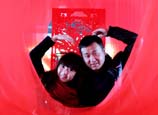
From "Made in China" to "Created in China": China's quest to reposition itself on the global map [Rediscovering the Awakening Dragon, Part I]
Cultural Spender Exudes Soft Power (People's Daily Online/Li Zhenyu)
To have a deeper understanding of the present, it is, often times, necessary to get a grip on history first, or to say, where China's present notion of innovation came from and how it unfolded into reality.
It came right from a national congress 10 years ago, a historical series of meetings that turned a whole new chapter in the history of China's cultural sector development.
The Not-so-good Old Times
A decade ago, the milestone strategy of "actively developing cultural undertakings and industry" unveiled at the 16th National Congress of Communist Party of China (CPC) changed the entire view of China's cultural sector.
The landscape of China's cultural sector 10 years ago was quite different from what it looks like now. At that time, the sector was heavily subsidized by the government.
Cultural entities like news organization, publishing house, film studio and theater were mostly public institutions funded by the government, and private capital was restricted from entering the cultural sector. Market competitions among cultural organizations were scare.
The vast majority of the well-received cultural contents consumed by the Chinese people were those imported from foreign countries, like Hollywood's blockbusters, Japanese cartoons and electric games, among others.
Workers in the cultural institutions have a secure lifelong job, and there was usually not much of a difference in their payment whether they had a good or bad performance.
The creativity of the people, in an ancient land rich in cultural resources and brimmed with millennia of wisdom, had remained hidden.

Recommended




















 China sends first oceangoing patrol vessel to South China Sea
China sends first oceangoing patrol vessel to South China Sea


![]()
